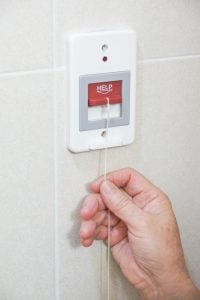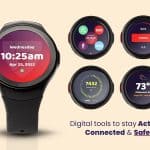
A fall can be scary, especially if you don’t have a way to contact help. A medical alert device can give you peace of mind.
When you think of staying safe and independent at home for as long as possible, a medical alert system is often an essential part of the plan. However, it can be difficult to determine which medical alert system and device best suits your budget, lifestyle, and needs. While many seniors choose to go with a monitored system, others find they can skip the monthly subscription fee and regular monitoring and instead choose an unmonitored option. Of course, this solution isn’t for everyone, but it might be for you or your loved one.
Here’s what you need to know in order to make your best decision.
What Is a Medical Alert System?
You might think of a medical alert system as a bright red pendant worn around the neck that can send help if you’ve “fallen and can’t get up”. These medical alert systems, sometimes called personal emergency response systems or PERS, leverage technology to keep adults safer and more connected to emergency responders.
Depending on what the user needs, the right medical alert system can provide assistance in case of a fall, medical emergency, health telemonitoring, or even confusion. Today’s medical alert companies offer a variety of solutions, giving adults and their family members the opportunity to select what type of device or services will suit them best.
Traditionally speaking a medical alert system includes an in-home base station that connects to a landline or cellular service. This base unit is typically placed next to the bed or in the family room and connects wirelessly to a pendant button that can be pushed in case of a fall or other emergency. Trained operators answer the call for assistance and can make any further calls to local emergency responders as necessary and notify family members.
Beyond the traditional home-based system, medical alert companies also now offer mobile or on-the-go systems for more active customers. These pendant, wristband, and belt-clip buttons often include GPS location as well as fall detection technology so that operators can be more proactive in responding to potential emergencies.
However, the monitoring services do come at a price. Monthly subscription fees can become expensive for adults on a fixed budget and depending on their situation, these seniors might choose to investigate a less costly option: unmonitored systems with no monthly fee.
How Does a No-Monthly-Fee System Work?
An unmonitored medical alert system doesn’t necessarily mean the user has no way of contacting emergency services. It just contacts those emergency responders a bit differently. In most cases, an unmonitored system connects via landline or cellular service and when the user presses their emergency button, they are immediately routed to 9-1-1 or designated emergency contact. In most cases, the device works as a two-way communication device as the user speaks right into the device in order to request assistance or report an emergency.
Other types of unmonitored systems do not call 9-1-1 at all and instead act as an alarm system to alert others in the home of a fall or emergency. These systems are a good solution for a senior who is living with a partner or other family member. If they fall or need assistance, they simply press a specific button or pull a cord and a loud alarm sounds. This alarm can be heard throughout the home and the family member or caregiver can respond accordingly.
Pros of an Unmonitored Medical System

Some unmonitored options are simple pull cords or alarms you can use in the home to alert a live-in caregiver that you need assistance.
As with any option, unmonitored medical systems come with a list of benefits and drawbacks. It’s important to weigh the pros and cons when determining if this solution would work for you and enhance your personal safety or confidence at home.
Benefits to an unmonitored medical system begin with the price. Depending on what type of services and devices you choose, a monitored system can have monthly fees ranging from $20-$80. For an unmonitored system, these monthly fees disappear and the user is only responsible for purchasing the device(s). There are no long or short-term contracts and the user can choose to stop using the device at any time without worrying about cancellation fees or procedures.
Other pros can include easier installation, more battery life (which means you won’t have to worry about a consistent charging schedule), and some devices like the Apple Watch include fall detection technology. Some unmonitored medical devices can also act as a daily communication device to call family members, eliminating the need to use a cell phone.
Cons of an Unmonitored Medical System
There are drawbacks to choosing an unmonitored medical system to consider. The first major drawback is the lack of monitoring from trained professionals in a monitoring center to answer the calls for emergency. When you set up a device with a monitored medical alert device system, you provide important information about your medical history, allergies, and medication information. These details can be quite important and are at the fingertips of the trained operator who answers the call for help. Operators can use this information to better communicate with a 9-1-1 dispatcher if necessary and give the most detailed review of the situation, including any potential medical complications.
Another drawback to choosing most unmonitored system is the fact that the user needs to push the button in order to get connected with a designated caregiver or 9-1-1. For monitored systems with fall detection technology, an operator can contact 9-1-1 on behalf of the user who might be unconscious or otherwise unable to request help on their own.
Finally, an operator who knows details about the user’s medical history and conditions can communicate on behalf of the user if the user is in pain, dizzy, or in the middle of an emergency that impairs their ability to speak. Without that additional support, the user could be without assistance for longer than necessary.
No Monthly Fee Medical Alert Packages We Reviewed
We specialize in reviewing and offering comparison tools for medical alert devices that offer monitoring services. However, companies like LogicMark offer multiple solutions for those looking to skip monthly fees and instead choose a system that is unmonitored. Here are a few options that we have broken down based on initial fee.
Budget Medical Alert Systems with No Monthly Fee
Most unmonitored medical alert systems that are inexpensive are those that do not offer two-way communication. Instead, these alarms are best used when the senior lives with a partner, family member, or caregiver.
You can find alarm buttons for as cheap as $10 on Amazon. Just be sure you find an alarm button that is loud enough for others in the home to hear and that the user has the ability to reach the button and use it effectively in case of an emergency.
Mid-Range Medical Alert Systems with No Monthly Fee
If you are looking for devices that act as a two-way communication device to dial directly to 9-1-1, you will have to pay more money. Most systems or devices that are available without a monthly fee start at around $100.
For example, the Life Guardian Medical Alarm Emergency Alert Phone is approximately $125 and includes a wristband button, pendant on a lanyard, and a communication base station. Similarly, the Silent Beacon Panic Safety Device is priced around $125 and can dial pre-designated numbers with a help message when pressed.
High-End Medical Alert Systems with No Monthly Fee
For a higher initial fee, you can also find medical alert systems with more bells, whistles, and perks while still avoiding a monthly subscription fee. The Home8 Video-Verified Medical Alert System costs about $300 (and is sometimes difficult to find), but offers caregivers the opportunity to check in on their loved one in real time thanks to live video streaming.
The Apple Watch is another option and something you may already own. The Apple Watch includes fall detection and other features depending on which Apple Watch series you choose. A person can also just use their smartphone as a way to reach people or 9-1-1 in case of an emergency. However, that person has to ensure they have their phone within reach at all times and are able to operate it.
Is a Medical Alert System with No Monthly Fee Right for Me?
While the absence of a monthly fee is certainly a benefit for unmonitored systems, choosing to have a medical alert system without the monitoring is definitely not right for everyone. For example, a no monthly fee option might not be best for you or your loved one if:
- There is any cognitive decline, or a diagnosis of Alzheimer’s disease or another type of dementia.
- There have been any instances of confusion or getting lost in the past year.
- There is a medical condition that increases the risk of falling, such as Parkinson’s disease or diabetes.
- There is the risk of fainting or becoming unconscious.
- The person is active and outside of the home at least once per day.
- There has been a fall in the past 12 months.
- The person has low vision or significant vision challenges.
- The person has an unsteady gait.
If you are unsure if an unmonitored medical alert system is appropriate and safe for your specific situation, speak candidly with a physician who knows about it. A physician can give you good advice on your current and future needs so that you can plan accordingly.
Affordable Alternative to Medical Alert Systems with No Monthly Fee
Here is the good news, especially if you or your loved one will feel safer and benefit from the unmonitored options: medical alert systems with a monthly fee are often quite affordable for most budgets. Many are less than $30 per month and companies like Bay Alarm Medical and Medical Alert by Connect America are less than $20 per month.
Unmonitored Medical Alert Systems FAQ
Choosing an unmonitored medical alert system is a significant decision and you should be sure you are clear on what to expect and what not to expect with the purchase. Here are some common questions about the option.
What does “unmonitored” or “non-monitored” mean?
An unmonitored medical alert system is one that is not monitored by operators and trained professionals at an off-site location.
How can I get help if I use an unmonitored medical alert system?
Depending on the system you choose, you can get help by having your system device dial 9-1-1 directly, or a caregiver.
Can I speak with 9-1-1 operators if I use an unmonitored medical alert system?
Not always. It depends on the communication device supplied by the medical alert system. Some do act as two-way communication devices, allowing the user to speak with 9-1-1 operators in real time. Other devices simply send a message of help to caregivers or 9-1-1 operators.
What if I lose consciousness?
If you lose consciousness and are unable to press your help button on the medical alert device, you might not receive assistance at all. Only a few unmonitored devices offer fall detection technology which would notice a potential fall and then follow-up.
Are unmonitored devices waterproof?
It depends on the device you choose. Some alert buttons are water resistant and you can feel comfortable taking them into the shower. Just be sure to read the details to ensure you are purchasing one that can be in the bathroom or shower.
What are the benefits of a monitored system?
There are plenty of benefits that go along with a monitored system, including peace of mind knowing the operators already have medical history and other information that can help them triage your emergency more efficiently.
Can’t I just use my smartphone as a medical alert device?
Thanks to technology, our smartphones can do almost anything for us, including calling for assistance in case of a fall. However, it’s important to note that unless you have your phone within reach at all times, you run the risk of not being able to use it if you fall or lose consciousness. For others living with cognitive decline, operating a phone in times of high stress or confusion can also be unrealistic.


